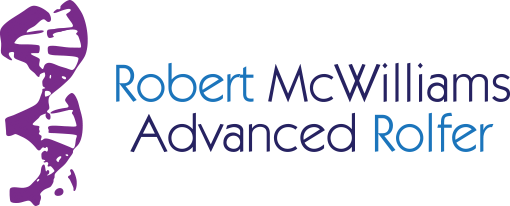The Psoas ( major): a pair of muscles that connect the lumbar spine and groin, joining at the lower attachment with the illiacus muscle that lines the pelvis, at the lesser trochanter bone. It is classically defined as an important hip flexor, though contemporary studies ( geeks see Yoshio, M et al, 2002, Journal of Orthopaedic Science, 7:199-207) call that into question. It is now viewed more a stabilizer for the lumbar spine, helping to maintain an appropriate lumbar lordosis curve. The psoas minor is said to serve the same function, but is often absent, and may be evolving out of the species. Why does it matter? I believe it matters because it helps us to coordinate between upper and lower body in a fluid and long-muscled erect posture. This is part of the “magic of normal function” that can heal many “ills”.
Ida Rolf was an early proponent of psoas assessment and treatment, and it is part of the “Core”work not usually handled in the Rolfing SI 10-series until sessions 4 and later. Certified Rolfers™, then, usually work through the body in layers, considering that psoas work should not be undertaken until the larger relationships, between, neck, thorax, pelvis, legs and feet, are put into better order.
A lot of clients have come to me with bad ( ie painful and innefective) “psoas therapy” stories. It has become a common treatment territory for massage therapists, PT’s and chiropractors. Mostly, they do this without any of the preparatory work mentioned above. They operate under the assumption that if an area is a concern, work on that area-without taking into account how well the client has been made ready for this treatment, which can mean the difference between small discomfort and agony-and how well the client will be able to adapt, in the rest of their body, to the new condition of the psoas. Treating any muscle in isolation may mean trouble, for successful therapy, in my opinion.
There are many gentle and effective techniques for achieving improved length, freedom and coordination through the psoas that are learned by Rolfers, especially those trained in Rolf Movement® work. We are trained in recognizing tendencies that may limit our stability and freedom of movement, and in ways to offer new options to clients in simple and more complex actions.The common activities we look at first our basic: breathing, standing, sitting, walking, and progress to more refined coordinations of limbs and core.
One very simplistic statement: sitting at a desk all day is slow-motion murder for all of us, period.The psoas becomes very weak, from slouching, or hyper-toned ( tight) from arching the back forward against the hips all day. Get up every twenty! Move around! Consider getting a standing desk. Exercise in ways that demand longer muscle use, like walking, running ( in moderation, with the running!) dance (with ease and flair!), swimming ( flutter kick is great for length in hips/thighs) yoga ( watch out on those “down dogs”!-is your shoulder girdle/upper spine ready for this?) and a number of devices, like the elliptical machine. Cycling is great exercise, but think about it: is the position you are in, while on the bike, really optimal for your neck, shoulders, low back, hips, and calves? The answer is no-but you can sort of “un-do” this with proper cross-training, ( see above) awareness of good alignment in normal functioning. A lot of dedicated cyclists walk kind of like they are still on the bike: tight shoulders and neck, forwards in the chest, hips tucked under in “posterior tilt”, very tight quads and hamstrings that lock up in walking, tight, unyielding calves that don’t allow the heels to release in their stride.
The psoas muscle, in this postural and functional pattern, is under-activated, often, in favor of a massive quadriceps muscle. Therapeutically, what is called for, if the client is having problems-probably with knees, hips or lower back, but also shoulders and neck, because of the bicyclists’ use-pattern-is work to free restrictions in the fascia-system to re-normalize posture, and movement re-education to allow underused postural muscles, like the psoas, to be more active, and over-used “phasic” or powerful, short-use muscles like the quads to more relaxed, longer and more flexible in motion.
We want to activate this muscle to gain good spacing and balance in the lower back-maintaining “neutral spine” in an appropriate level of lordosis for that individual structure and function. To me, psoas activation is primarily a coordination question. In dance, we talk about a sense of length down the back and throughout the leg, in hip flexion, together with a sense of dropping the sitz bone down to lift the thigh. In sum, it is a co-ordinative pattern, relating legs, pelvis and spine, that is key for proper activation. The focus, in dance, is often termed balance between concentric, eccentric and isometric contraction in use, making for beautiful and effective training and performance. Learning to maintain neutral spine while working the legs to the front and side is a strong challenge to lumbar spine stability, activating the psoas major, I believe.
The “magic” of normal function, lost in our sedentary culture, often heals many of our physical “ills”!
( Caution: brain pain may ensue here!) Rolfers look for a sense of length of hip/thigh/heel in the back leg in gait, as this is a sign that the psoas is able to lengthen. When it can do this, it will reflexively contract, appropriately, causing posterior tilt in the same side of the pelvis, which sets off a long stretch-reflex action activating hip flexors, to bring the knee forward to step, in the next gait phase, without undue effort by the hamstrings on that side.
(Okay, relax!!) So, gaining good co-ordination in this chain of actions can help prevent or heal low-back, hip, knee and foot pain!
